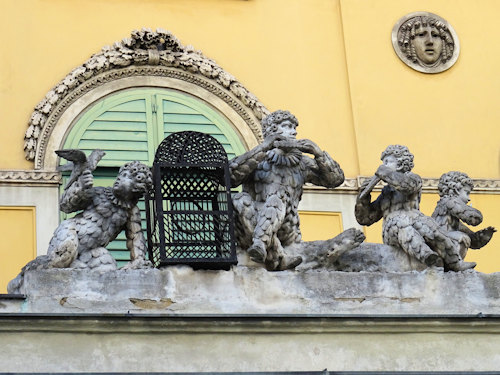
Vienna’s newest opera house is actually its oldest. The Theater an der Wien began life over two centuries ago as a venue for all sorts of musical entertainment.
- The colourful history dates back to 1801
- A fully-fledged modern opera house since 2006
- Hosted premieres by Beethoven, Strauss, Schubert, and others
- Performances elsewhere until renovations finish in 2024
- See also:
Vienna’s “oldest” opera house

(The city’s old & new operatic address)
Theater an der Wien broadly means “Theatre by the River Wien”, which might surprise you if you saw the place: any water is notable only for its absence.
The building certainly used to be close to the river. But engineers sent the Wien underground here over 100 years ago. So the water runs past below the Naschmarkt international open-air market opposite. You actually see it on the Third Man sewer tour.
Anyway, the Staatsoper may hold the number 1 spot when it comes to opera houses in Vienna, but the Theater an der Wien certainly beats its illustrious colleague on one measure: age.
A brief history
A fellow named Emanuel Schikaneder built the original theatre in 1801 (more on him later).
A chequered history then followed, with an ever-changing repertoire of musical and theatrical styles and genres, occasional periods of disuse, periods of great popularity (like today), and various rebuilds, refits and refurbishments.
Perhaps appropriately, then, productions have shifted to other locations at the moment while the main building undergoes major renovations. Expect a reopening in autumn 2024.

(The front entrance pre-refurbishment)
The Staatsoper even moved in here for a while while its own house was rebuilt post WWII. Afterwards, the Theater an der Wien slowly morphed into a successful venue for musicals before reopening as a dedicated opera house in 2006.
In its modern guise, the house has built an excellent reputation and become a significant player on the global opera scene.
For example, the Theatre an der Wien won a 2016 International Opera Award for a new production of Peter Grimes and received nominations in the awards’ 2019 Opera Company and 2020/2021 Education & Outreach categories.
The composer connections
Not only does the Theater an der Wien put on works by the world’s great composers, but the institution has a strong historical connection to several of these musical geniuses.
Emanuel Schikaneder, who you’ll remember built the place, actually wrote the libretto to Mozart’s The Magic Flute and played the role of Papageno himself.
Nip around the side of the building to see the old Papagenotor entrance, which immortalises a key scene in the opera:

(Schikaneder’s famous role immortalised in stone)
The connection to Beethoven is even stronger. He lived and worked here for a while; several of his compositions – including three symphonies – premiered here, too.
The Theater an der Wien even hosted the first-ever performance of Beethoven’s only opera. For ten Gulden, you could get the best seat in the house for the opening night of Fidelio on Wednesday, November 20th, 1805 (beginning at 6.30pm).
Beethoven was not the only famous composer to celebrate a premiere here. Others include, for example:
- Schubert (e.g. Die Zauberharfe in 1820)
- Johann Strauss II (e.g. Die Fledermaus in 1874)
- Franz Lehár (e.g. Die lustige Witwe in 1905)
Not every premiere proved an unqualified success, though. One reviewer wrote of Strauss’s work (my translation):
Die Fledermaus fluttered for the first time through the house. Since its musical wings and librettistic tail had grown too pitifully short, it flopped. Poor Fledermaus.
Unlike the Theater an der Wien and Strauss’s famous operetta, that review has not aged well.
If you visit, be sure to wander up and down the road a bit. Quite apart from the joys of the Naschmarkt, both the golden-domed Secession building and Otto Wagner’s gorgeous Majolikahaus are close by.
How to get to the Theater
A major subway station (Karlsplatz on the U1, U2 and U4 lines) is just a short walk away; take the exit marked Secession from the station. Other nearby subway stations include Kettenbrückengasse on the U4 and Museumsquartier on the U2.
The bus 59A stops at Bärenmühldurchgang, which is also close by.
Address: Linke Wienzeile 6, 1060 Vienna | Website